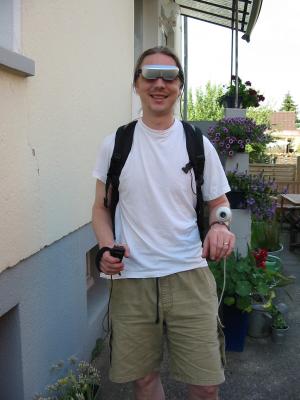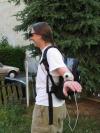... as I love computing and to be online I got interested in the MIT wearable-computer-research project
(http://www.media.mit.edu/wearables/).
Especially inspired by the cyborg Steve Mann (http://wearcam.org/pictures.html),
I decided to built myself a "5. generation wearcomp" based on a notebook computer.
Overview
base computer
used parts
used OS/applications
assembling
keyboard/mouse input
head-mounted-display
hand-mounted-cam
networking/clustering
power
purpose
ideas about further usage
pictures
links
disclaimer
A real advantage (for me) to use a notebook instead of e.g. an handheld-device or
a P104 computer as the base is to have a fast, standard pc-environment
(IA32 architecture) on which all regular Linux-kernels and applications
can be used. Also, all standard pc-equipment (such as webcams, PCMCIA add-on cards,
USB-storage...) are directly connectable without the need to e.g. building/using converters
for various hardware interfaces. The (for me acceptable) disadvantage is that it needs more space (requires backpack).
used parts
- one of my notebooks as the base-computer (AMD 1.8 GHz/125MB RAM)
- PCMCIA wireless network card
- Hand View VGA-to-PAL converter from Grandtec powered by USB
- Olympus Eye Trek FMD-200 video-glasses powered by a self-made 7.5V akku-pack
- Twiddler2 from http://www.handykey.com/ powered by USB
- Logitech Quickcam Express (connected to USB)
- Linux kernel vmlinuz-2.4.22-openmosix3
- full RedHat 9 Linux distribution
- special configured Gnome desktop (increased contrast and using bigger fonts for HMD)
- all common Linux applications including openMosix clustering tools
For my personal wearable I cared especially about using "standard-parts"
which are available in most "good-sorted" computer-shop. Also, this "thing" shouldn't be too expensive and the used parts should
be used "as they are" or as less modified as possible.
So assembling was quite easy expect I had find a proper solution for
the 7.5V power-consumption the video-glasses needs. My "electronic shop of my trust" helped me in this decision and now
I am using a simply, cheap and powerful battery-pack (5 x 1.5V) with
re-chargeable akku-batteries
(to my mind even better than the small akku you can buy for these video-glasses from Olympus).
One thing I had additional to care about was how to place the notebook
within the back-pack in a robust way (I do not want to harm it). Problematic was also to "save some space" for the USB/Audio connectors.
The solution I choose was the build a small-case out of a carton with
some "soft-separators" which makes the computer fit into the back-pack perfectly.
I am using a Twiddler2 and I am very satisfied with it :) Even people without any experiences in, e.g., 10-finger typing on a regular keyboard
can learn to touch-type with this "one hand keyboard" within a few hours.
The pre-programmed chords (finger combinations for different letters)
are easy to get used to and the build-in "thumb-mouse" is comfortable to use
(also very useful for presentations). Compared to other "one hand keyboards" or "keygloves" the Twiddler2 is a reasonable
alternative to a regular keyboards.
The trickiest part of a "wearable computer" is the display/monitor. After gathering some
information about possible solutions I decided
for a HMD, a head-mounted-display. Most of video-glasses which offer "looking through" are either horrible
expensive or do not have an acceptable/usable video-size for relaxed working.
Because I designed my personal in particular for usability in daily working
situations I decided to use video-glasses from Olympus (bought from ebay for a few bucks).
Those glasses offers a high quality video-output with which one actually
are able to work with a regular X-desktop. I am using a "Grandtec hand view" VGA-to-PAL converter which displays my Gnome desktop
in a 640x480 pixel resolution which I set virtual to 1024x768. This makes it very comfortable to use with regular applications which normally
fill-up the "mini-desktops/window-mangers" designed, e.g., for "Linux on
handhelds".
Because the video-glasses used do not allow one to "see through"
(but having a higher quality display) I needed a possibility to enable at
least a "small view" to the "outside reality". For this purpose I am using a "HMC" (hand-mounted-cam).
I thought about this "outside view" quite a longer time and found no
acceptable solution for mounting the small webcam onto my head
without using e.g. a baseball-cap or an other kind of headband which I want to avoid (uncomfortable, the video-glasses should be the only
thing on my head for this wearable). To still provide some possibility to move the cam around
(even if it not follows my head-moving) I decided to simply mount it on my
left wrist. This does not hinder me in any way to use the left-free hand
but enables some other kind of "funny tricks" e.g. :
- you can look at higher roofs while just pointing the cam above the head
- you can look into small "holes" in difficult-to-reach areas
- you can "spy" around corners ;)
- you can look around without stopping to concentrate on work
The used base computer (one of my notebooks) offers all kinds of different
network connections. Normally it can be connected to any wireless LAN
(using a wireless PCMCIA or USB network adapter). Also, it has a built-in 100Mbit network card which
I can use to connect
to any local network-switch/hub by a short network-cable in my pocket. .... really a funny thing to be actually a part of an openMosix-cluster ;)
The power-supply, by akku, of the notebook is quite satisfying (have one spare akku for exchanging).
It allows approximately 1-2 hours working time (per akku). Most used devices like the VGA-to-PAL converter, the Twiddler and
the webcam are USB devices powered by the built-in 5V power-supply
within the USB-host. The only device which required to built an
akku by myself is the Olympus FMD-200 Eye-trek video glasses. Those glasses needs 7.5V with about 400mA power assumption and
I assembled a custom akku-pack for it from battery cases using battery-akkus
(cheap + powerful solution -> see the pictures).
;) Mostly to build this "personal wearable" just for fun even if to put some effort in it
to make it really usable (at least for me) in daily working conditions.
I thought about a "real navigation system" which e.g. displays "virtual footsteps"
on the "real road" which the user views through the outside cam. The idea is to connect a GPS-device to a
"on-the-fly" video-editing/effect engine
to display the "footsteps" or e.g. arrows on the street. Another idea might be to
automatically form cluster from cyborgs
(people using wearable computers) and support ,e.g.,
switching from the SETI-project-cluster to the DistributedNet cluster
just by physically changing the location/room.
pictures
wearable computing at MIT
http://www.media.mit.edu/wearables/
Steve Mann's wearcomp
http://wearcam.org/pictures.html
Ripley wearable computer project
http://www.linuxdevices.com/articles/AT8144626322.html
2nd Generation iPAQ Wearable Computer
http://www.iptel-now.de/PROJECTS/WEARABLE/2G_IPAQ_WEARABLE/2g_ipaq_wearable.html
wearables central
http://wearables.blu.org/
Twiddler2
http://www.handykey.com/
video glasses at ebay
http://video.listings.ebay.de/Fernseher_Videobrillen_W0QQfromZR4QQsacategoryZ11385QQsocmdZListingItemList
All instructions, code and applications here are without guarantee.
All trademarks, service marks, and copyrights are property of their respective owners.
The Author is not responsible for any mistakes and their consequences while using this instructions on your system.
Matt Rechenburg (mosixview@t-online.de)
Many thanks to Bruce Knox for making minor changes and updating this page to a much more nicer outfit.

This page is: http://www.openmosixview.com/wearable/

 the 1st packMann node
the 1st packMann node  the 1st packMann node
the 1st packMann node 





